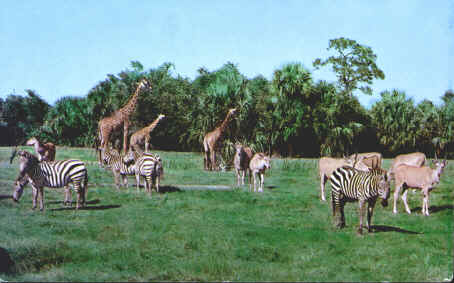 |
Abyssinian
Asses -
The small, docile donkey like animal,
made famous as the animal Jesus rode into
Jerusalem.
|
 |
Aoudad -
Also known as the Barbary Sheep from
Northern Africa famous for their long
backward curving horns.
|
 |
Baboon
-
A primate of East Africa, are
very social and like to interact with
humans. Click
here
for more information about
baboons from the African Wildlife
Foundation.
|
 |
Camels
- These
ancient beasts of burden were Dromedary
Camels. They are most commonly found in
Northern Africa.
|
 |
Cheetah
- This
elegant and graceful member of the cat
family was very popular at Africa U.S.A.
Mojah and Mbili, which means "One"
and "Two" in swahili, were tame
house pets. Click
here for
more information about cheetahs from the
African Wildlife Foundation.
|
 |
Chimpanzee
- Many
chimpanzees lived at Africa U.S.A., most
famous of which was Princess Margaret. Click
here to
learn more about chimpanzees from the
African Wildlife Foundation.
|
 |
Eland
- This
cow-like creature is actually the largest
antelope in the world. Africa U.S.A.
owner John Pedersen had hoped that eland
would be as common as cows in Florida. Click
here to
learn more about eland from the African
Wildlife Foundation.
|
 |
Elephant
- The
elephants at Africa U.S.A. were actually
Asian elephants rescued from circuses. Click
here to
learn more about elephants from the
African Wildlife Foundation.
|
 |
Gazelle
- The
most common gazelle in East Africa,
Thomson's gazelle were a common site in
Africa U.S.A. Click
here to
learn more about Thomson's Gazelle from
the African Wildlife Foundation.
|
 |
Giraffe
- These
tall elegant, friendly creatures are
really a sight to behold. Africa U.S.A.
had many giraffe, including Champ. Click
here to
learn more about giraffes from the
African Wildlife Foundation.
|
 |
Gnu
-
Also known as wildebeest, they
are in the antelope family. Two of the
gnus were named "Good Gnus" and
"Bad Gnus." Click
here for
more information about wildebeest from
the African Wildlife Foundation.
|
 |
African Gray Crowned
Crane - Native to South Africa,
these beautiful cranes have a golden
crest or crown. They were part of the
original animal shipment from Africa.
|
 |
Manatee - These aquatic
mammals, also called "sea cows"
are still frequently found in the
Hillsborough Canal.
|
 |
Monkeys
- The
monkeys at Africa U.S.A. were located on
monkey island. A variety of South
American monkeys such as capuchin monkeys
lived many years in the area long after
Africa U.S.A. was closed.
|
 |
Nilgai
- Also
called the Bluebuck, this member of the
cattle family is native to Southeast Asia.
|
 |
Nyala - These members of
the cattle family are from Southern
Africa and are grazing animals.
|
 |
Ostrich
- These
tall birds produced eggs that were sold
commercially throughout the United States.
Native to Central Africa, ostrich can
achieve a height of 12 feet.
|
 |
Peacocks - These beautiful
multi-color birds were a common site at
Africa U.S.A. After the attraction closed
the peacocks still roamed the area and
the Camino Gardens neighborhood placed
colorful "Peacock Crossing"
signs through the area.
|
 |
Sitatunga
- The
sitatunga is an amphibious antelope that
lives in Kenya and Tanzania. Click
here
for more information on
sitatunga from the African Wildlife
Foundation.
|
 |
Zebra
-
These familar striped members of the
horse family were an extra special
attraction at Africa U.S.A. Two species
of zebra were featured. Chapman's zebra
or the common zebra were featured along
with the larger Grevey's zebra. Almost
extinct in the wild, Grevey's zebra have
much finer stripes and a white underbelly
to distinguish them from Chapman's zebra.
Click
here for
more information on zebras from the
African Wildlife Foundation.
|
 |
Zee-Horse
-
"Tiger" the Zee-Horse had a
zebra father and an English racehorse
mother. This unique one-of-a-kind
creature was a popular Africa U.S.A.
attraction. Click
here to
read about the recent birth of a zee-horse
in England.
|
| |
Please
sign our
GUESTBOOK
|
| |


|
| |